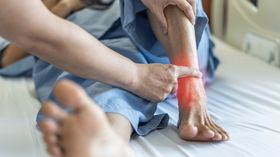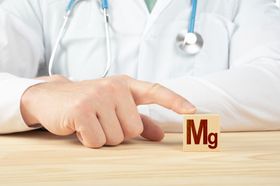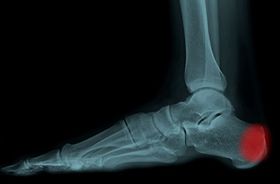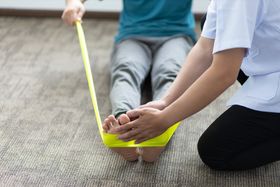Aching Calves: How to Identify & Treat the Real Issue
Calf pain isn’t just from shoes or workouts; it can stem from overuse, nerve issues, clots, tendon damage, or circulation problems. Each cause needs its own treatment.
Published October 27, 2025

Your calves shouldn't hurt after a normal day. Yet millions of people wake up with tight, aching calf muscles or feel sharp pain when they bend their knees.
Most people blame their shoes or assume they overdid yesterday's workout. The real culprits run much deeper.
» Want to stop aching Calves? Find the best insoles to treat calf pain
7 Most Common Reasons Hurt
1. Muscle Overuse and Cramping
Standing all day at work wreaks havoc on your calf muscles. So does that weekend hiking trip when you haven't exercised in months [1].
Your muscles build up lactic acid. Without proper hydration, your electrolytes get out of balance. Result? Those painful knots that make you want to sit down immediately.
- What It Feels Like: Sharp, sudden pain that comes and goes. Often happens during physical activity or right after. The muscle feels tight and tender to touch.
- Timeline: Usually resolves within hours to a few days with rest.
2. Sciatic Nerve Problems
Your sciatic nerve runs from your lower back down the back of your leg. Behind the knee, it branches into two nerves: the tibial nerve (which innervates your calf) and the common fibular nerve (which serves the outer leg and foot).
When nerve irritation occurs, whether from a bulging disc, muscle tightness, nerve tension, or postural dysfunction, you feel it radiating down your leg [2]. Disc herniation is one common cause, but far from the only one.
This isn't just muscle pain though. The nerve compression sends shooting sensations down your entire leg.
- What It Feels Like: Deep aching that might include tingling or numbness. Conditions like sciatica or blood clots are among the main causes of calf pain in one leg. If the pain stays on one side and doesn’t ease with rest, it’s worth getting checked.
- Timeline: Can be chronic and persistent until the nerve compression gets addressed.
» Find out if ice or heat is better for sciatica
3. Blood Clots (Deep Vein Thrombosis)
This is the scary one. A clot forms in the deep veins of your calf, blocking blood flow [3]. Unlike muscle soreness, this pain doesn't improve with rest or stretching. It often gets worse.
- What It Feels Like: Constant cramping and soreness. Your calf may swell up or change color. Pain increases when you flex your ankle.
- Timeline: Persistent and may worsen quickly. Requires immediate medical attention.
4. Achilles Tendon Issues
Your Achilles tendon connects your calf muscle to your heel bone [4]. Too much activity without proper warm-up inflames this crucial connector. Morning stiffness is the telltale sign. Those first few steps out of bed hurt the most, which means you're dealing with Achilles tendonitis.
- What It Feels Like: Sharp pain at the back of your heel that radiates up into your calf. Worse in the morning and when you touch the tendon area.
- Timeline: Develops gradually over weeks. Morning pain that improves with movement, then returns after activity.
» Check out the worst shoes for Achilles tendonitis
5. Muscle Tears and Pain in the Upper Calf
Pop. That sudden sharp pain when you jump or sprint means you've torn muscle fibers [5]. This happens when you ask cold muscles to do too much too fast. Your calf muscle literally pulls apart.
- What It Feels Like: Sudden, severe pain in the middle or upper calf during movement. Walking becomes difficult within hours. Swelling follows.
- Timeline: Immediate onset with progressive worsening over the first 24-48 hours.
6. Poor Circulation
When blood doesn’t flow properly, the muscles ache from lack of oxygen. This type of poor circulation usually causes pain in both calves, especially after long periods of sitting or standing.
- What It Feels Like: Dull, persistent aching that may worsen with activity. Often affects both calves equally.
- Timeline: Chronic condition that may fluctuate based on activity levels and overall health management.
» Find out how to treat tingling in your feet from poor circulation
7. Muscle Imbalances
Your body is a chain. When one link is weak or tight, other parts compensate. Weak glutes force your calves to work overtime. Tight hip flexors change how you walk. Your calves pay the price.
- What It Feels Like: General soreness and fatigue, especially after walking or standing. May develop gradually over time.
- Timeline: Develops slowly over weeks or months as compensation patterns become established.
» Learn how insoles can fix gait imbalances
Expert Note: This guide provides evidence-based information about calf pain causes and treatments, but it does not replace personalized medical advice. If you experience persistent, severe, or worsening symptoms, consult a healthcare provider for proper diagnosis and treatment planning.
When Calf Pain Becomes Dangerous
Certain symptoms require immediate medical evaluation, often same-day or emergency care. Seek urgent attention if you experience:
- Sudden severe pain with ankle swelling: Potential blood clot (DVT)
- Chest pain or shortness of breath with calf pain: Possible pulmonary embolism
- Numbness, tingling, or weakness spreading down your leg: Nerve damage progression
- Pain so intense you cannot bear weight: Complete muscle tear or compartment syndrome
- Skin color changes (red, purple, or pale) in your calf or foot: Circulation emergency
These symptoms can signal blood clots, nerve damage, or complete muscle tears. Do not wait to see if it gets better. Early intervention prevents serious complications.
How to Treat Different Types of Calf Pain
Below I've prepared a couple of treatments for aching calves, depending on the root cause of your pain:
For Overuse and Muscle Fatigue
Start with gentle calf stretches. Hold each stretch for 30 seconds, repeat 3 times daily. Massage helps too. Use your hands or a foam roller to work out the knots. Try contrast therapy: alternate between ice packs (10 minutes) and heat (15 minutes). This reduces inflammation and improves blood flow.
- Prevention: Take breaks every hour if you stand all day. Build up activity levels gradually rather than jumping into intense exercise.
» Check out the best insoles for nurses to relieve fatigue
For Poor Circulation Issues
Compression stockings become your best friend. They prevent blood from pooling in your legs. Exercise regularly, but start small. Even 10-minute walks help improve circulation. Elevate your legs above heart level for 15 minutes several times per day.
- Medical integration: Work with your doctor to manage underlying conditions like diabetes or heart problems that affect circulation.
For Nerve-Related Pain
Stretching helps, but it's different stretching. Focus on your hamstrings, glutes, and lower back muscles to take pressure off the sciatic nerve. Heat therapy works better than ice for nerve pain. Use heating pads or warm baths to relax muscle spasms.
Strengthen your core and glute muscles. When these muscles work properly, they take pressure off your sciatic nerve.
When to seek specialized treatment: If 2-3 weeks of consistent stretching and core strengthening don't reduce your symptoms, consult a physical therapist. Nerve-related pain often requires manual therapy, targeted exercises, and assessment of underlying biomechanical issues that self-treatment cannot address. Persistent nerve symptoms can worsen without proper intervention.
For Injuries and Tears
Follow the PEACE + LOVE protocol for acute injuries:
PEACE (first 3 days):
- Protect the injured area
- Elevate your leg
- Avoid anti-inflammatory medications initially
- Compress with an elastic bandage
- Educate yourself about the injury
LOVE (after 3 days):
- Load the muscle gradually with gentle movement
- Optimize your recovery with proper nutrition
- Vascularize through light cardio to improve blood flow
- Exercise progressively to rebuild strength
» Explore the most common foot injuries you might get while hiking
For Muscle Imbalances
You need all three: stretching, strengthening, and mobility work.
- Stretch your calves daily, but also stretch your hip flexors and hamstrings.
- Strengthen through eccentric exercises. Heel drops work well: stand on a step, rise up on your toes, then slowly lower your heels below the step level.
- Mobility exercises keep your ankles moving properly so your calves don't compensate.
The Role of Systemic Conditions
Diabetes, autoimmune disorders, and other health conditions can cause calf pain. Management becomes more complex. You still need stretching and gentle strengthening, but medical management takes priority.
Compression stockings help with swelling. Custom orthotics distribute weight evenly and prevent pressure points that could become problems.
Work closely with your healthcare team. Self-management alone is insufficient when systemic disease drives your symptoms. Your physician needs to monitor for complications like peripheral neuropathy, vascular insufficiency, or medication interactions that affect muscle function.
» Learn everything there is to know about diabetic foot
Lesser-Known Causes to Consider
- Infections: Rare but serious. Bacterial infections or abscesses in calf muscles cause severe pain with fever and rapid worsening.
- Medication Side Effects: Statins and corticosteroids can cause muscle weakness and cramping in some people.
- Popliteal Artery Entrapment: This condition compresses the artery behind your knee. Pain increases with activity and may affect athletic performance.
When Supportive Aids Help Aching Calves
Custom orthotics work best when foot mechanics contribute to calf pain. If you're compensating for flat feet, high arches, or other foot issues, your calves work overtime.
Orthotics provide support during acute flare-ups and maintenance during recovery. They're most effective for biomechanical causes rather than circulation or nerve problems. Compression garments help immediately with circulation issues and can reduce muscle soreness from overuse.
» Check out our list of the top insoles to alleviate calf pain in athletes
Can Calf Pain Resolve On Its Own?
Calf pain from simple muscle fatigue usually disappears within hours of rest. Exercise-related soreness typically peaks 24-48 hours after activity, then gradually improves over 3-5 days. Your body's natural healing mechanisms work well for minor overuse when you allow adequate recovery.
However, pain lasting beyond one week without improvement needs an evaluation. Pain that worsens despite rest, interferes with daily activities, or accompanies other symptoms (swelling, numbness, weakness) requires professional assessment.
Natural resolution applies to minor muscle fatigue, not to structural injuries, nerve problems, or circulation issues.
Activity Matters More Than You Think
Your lifestyle determines both your pain patterns and treatment approach.
- Athletes need different management than office workers. High-impact sports create different problems than prolonged sitting.
- Active people often need intensive rehabilitation and gradual return to activity protocols.
- Sedentary individuals typically benefit more from ergonomic modifications, supportive devices, and gentle movement programs.
The key is matching your treatment to your activity level and life demands, not just treating symptoms in isolation. Your calves are trying to tell you something. Listen to what they're saying, identify the real cause, and treat it properly. Your legs will thank you.
» Check out the best insoles for everyday activity
The Real Answer to "Why Do My Calves Ache?"
Your calf pain has a specific cause, and accurate identification determines treatment success. Sharp pain that comes and goes typically points to muscle overuse. Persistent aching with tingling suggests nerve involvement. Constant pain with swelling demands immediate medical attention.
For biomechanical causes like muscle imbalances or compensatory movement patterns, custom orthotics from Upstep provide targeted support that addresses foot mechanics, forcing your calves to work overtime.
Self-management works well for minor overuse and fatigue-related calf pain. However, persistent symptoms lasting more than 2 weeks, progressive worsening, or any red flag symptoms (sudden severe pain, swelling, numbness, skin color changes) require evaluation by a healthcare provider.
A physical therapist or physician can diagnose underlying structural issues, nerve problems, or circulation disorders that need specialized treatment beyond home remedies.
References:
- K. C. Miller, M. S. Stone, K. C. Huxel, and J. E. Edwards, “Exercise-Associated muscle cramps,” Sports Health a Multidisciplinary Approach, vol. 2, no. 4, pp. 279–283, Jul. 2010, doi: 10.1177/1941738109357299. Available: https://pmc.ncbi.nlm.nih.gov/articles/PMC3445088/
- D. K. Clawson and H. J. Seddon, “THE LATE CONSEQUENCES OF SCIATIC NERVE INJURY,” Journal of Bone and Joint Surgery - British Volume, vol. 42-B, no. 2, pp. 213–225, May 1960, doi: 10.1302/0301-620x.42b2.213. Available: https://doi.org/10.1302/0301-620x.42b2.213
- A. Banerjee, “The assessment of acute calf pain,” Postgraduate Medical Journal, vol. 73, no. 856, pp. 86–88, Feb. 1997, doi: 10.1136/pgmj.73.856.86. Available: https://pmc.ncbi.nlm.nih.gov/articles/PMC2431219/#:~:text=For%20emergency%20department%20use%2C%20initially,assessment%20of%20the%20ambulatory%20patient.
- T. P. Vo, G. W. K. Ho, and J. Andrea, “Achilles Tendinopathy, A brief review and update of current literature,” Current Sports Medicine Reports, vol. 20, no. 9, pp. 453–461, Sep. 2021, doi: 10.1249/jsr.0000000000000884. Available: https://pubmed.ncbi.nlm.nih.gov/34524189/
- A. Prakash, T. Entwisle, M. Schneider, P. Brukner, and D. Connell, “Connective tissue injury in calf muscle tears and return to play: MRI correlation,” British Journal of Sports Medicine, vol. 52, no. 14, pp. 929–933, Oct. 2017, doi: 10.1136/bjsports-2017-098362. Available: https://bjsm.bmj.com/content/52/14/929.abstract
Disclaimer: The information on this blog is for educational purposes only and is not a substitute for professional medical advice. Upstep does not provide medical diagnosis or treatment. While qualified podiatrists create our content, it's essential to consult with your healthcare provider for any foot or ankle concerns you may have.
FAQs
Can dehydration cause calf pain?
Yes. Dehydration can lead to muscle cramps and tightness, including in the calves, because low fluid and electrolyte levels affect muscle function.
Is walking good for calf muscles?
Yes. Walking strengthens and stretches the calf muscles, improves circulation, and can help reduce stiffness.
Should you stretch sore calves?
Gentle stretching is safe and can relieve soreness, but avoid aggressive stretching if the pain is sharp or severe.
Is it bad to massage calf muscles?
No. Light to moderate massage can ease tension and improve blood flow, but stop if you feel sharp pain or have an injury like a clot or tear.
Can too much sugar cause leg cramps?
Indirectly, yes. Excess sugar can lead to imbalances in blood sugar and electrolytes, which may trigger leg cramps in some people.











